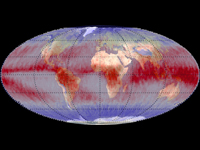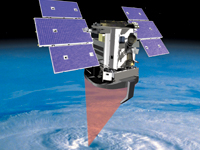CloudSat Project Yields Two Years of Data to Study Cloud Impact on the Climate
 |
|
Cloud activity (heating clouds in red, cooling clouds in blue).
|
The CloudSat mission, led by Colorado State University Professor Graeme Stephens, recently passed its second anniversary on April 28th. The two year’s worth of data collected by the satellite’s vertical imagery technology is significantly adding to our understanding of the effects that clouds have on the thermal energy being emitted from Earth to space, and on the amount of sunlight that passes through the atmosphere. Since these are the two sources of energy that define the Earth's climate, a better understanding of the effects that clouds have on the balance between them helps improve our ability to predict climate change.
"Observations of cloud vertical structure have been relatively primitive until now," said Stephens,"but CloudSat will help to fill major observing gaps." CloudSat flies at seven kilometers per second and goes around the Earth every 99 minutes, repeating the same ground track every 16 days. To get its data, CloudSat uses a radar instrument that produces millimeter wavelength energy; these waves of energy are the approximate thickness of a dime. This unique radar is over 100 times more sensitive than existing weather radars and can detect much smaller particles of ice and water than more conventional centimeter wavelength radars. The vertical imagery is transmitted from the spacecraft about seven times per day, making new data available every three to eight hours.
In looking at the information provided by the vertical images, there is a lot to learn about the contribution of clouds to global climate change. "The analysis confirms that the total contribution of clouds to atmospheric radiative heating is small on the global scale due to a cancellation of the much larger regional heating of high clouds in the tropics and cooling from low clouds at higher latitudes," said Tristan L’Ecuyer, a research scientist in the Department of Atmospheric Science.
However, there is a concern that increased pollution, when concentrated in one region, might lead to an offset of this balance by affecting one type of cloud and not the other. "Small changes in the amount of each cloud type that could occur as the climate gets warmer, could have a significant impact on regional energy balance. Since it is difficult to predict exactly how clouds will change in the future, their impacts represent an important source of error in current predictions of future climate." said L’Ecuyer.
 |
|
The CloudSat satellite..
|
CloudSat, along with other satellites including CALIPSO (Cloud-Aerosol Lidor and Infrared Pathfinder Satellite Observations) are part of NASA’s constellation known as the "A-Train", named for the way the satellites are grouped and fly together. The combined satellites of the A-Train are the most advanced to date in observing and collecting information on different aspects of the atmosphere.
"One of the interesting results that continues to emerge from current climate research is the large number of possible ways the climate can respond to human activity and, even more surprisingly, just how many of these responses we don't fully understand. My research involves studying our current climate to get a clearer picture of how clouds in the atmosphere interact with sunlight and thermal energy that comes from the Earth's surface. The better our understanding of the effects of clouds on the balance between these two sources of energy, the better we will be able to predict future climate," states L’Ecuyer.
The team’s long-term goal is to continue to collect data over the course of the mission that will lead to improved climate model predictions. The vertical images of clouds provided by CloudSat will further benefit the accuracy of future weather forecasting.